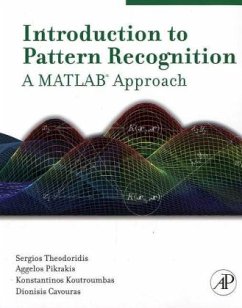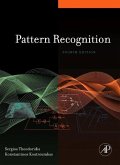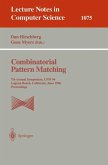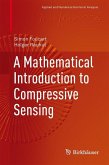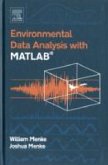Sergios Theodoridis, Aggelos Pikrakis, Konstantinos Koutroumbas
Introduction to Pattern Recognition
A Matlab Approach
Sergios Theodoridis, Aggelos Pikrakis, Konstantinos Koutroumbas
Introduction to Pattern Recognition
A Matlab Approach
- Gebundenes Buch
- Merkliste
- Auf die Merkliste
- Bewerten Bewerten
- Teilen
- Produkt teilen
- Produkterinnerung
- Produkterinnerung
Introduction to Pattern Recognition: A Matlab Approach is an accompanying manual to Theodoridis/Koutroumbas' Pattern Recognition.
It includes Matlab code of the most common methods and algorithms in the book, together with a descriptive summary and solved examples, and including real-life data sets in imaging and audio recognition.
This text is designed for electronic engineering, computer science, computer engineering, biomedical engineering and applied mathematics students taking graduate courses on pattern recognition and machine learning as well as R&D engineers and university…mehr
Andere Kunden interessierten sich auch für
![Pattern Recognition Pattern Recognition]() Konstantinos KoutroumbasPattern Recognition75,99 €
Konstantinos KoutroumbasPattern Recognition75,99 €![Computer Manual in MATLAB to Accompany Pattern Classification Computer Manual in MATLAB to Accompany Pattern Classification]() David G. StorkComputer Manual in MATLAB to Accompany Pattern Classification62,99 €
David G. StorkComputer Manual in MATLAB to Accompany Pattern Classification62,99 €![Combinatorial Pattern Matching Combinatorial Pattern Matching]() HirschbergCombinatorial Pattern Matching39,99 €
HirschbergCombinatorial Pattern Matching39,99 €![Combinatorial Pattern Matching Combinatorial Pattern Matching]() Farach-ColtonCombinatorial Pattern Matching39,99 €
Farach-ColtonCombinatorial Pattern Matching39,99 €![A Mathematical Introduction to Compressive Sensing A Mathematical Introduction to Compressive Sensing]() Simon FoucartA Mathematical Introduction to Compressive Sensing61,99 €
Simon FoucartA Mathematical Introduction to Compressive Sensing61,99 €![Fuzzy Classifier Design Fuzzy Classifier Design]() Ludmila I. KunchevaFuzzy Classifier Design113,99 €
Ludmila I. KunchevaFuzzy Classifier Design113,99 €![Environmental Data Analysis with MatLab Environmental Data Analysis with MatLab]() William MenkeEnvironmental Data Analysis with MatLab56,99 €
William MenkeEnvironmental Data Analysis with MatLab56,99 €-
-
-
Introduction to Pattern Recognition: A Matlab Approach is an accompanying manual to Theodoridis/Koutroumbas' Pattern Recognition.
It includes Matlab code of the most common methods and algorithms in the book, together with a descriptive summary and solved examples, and including real-life data sets in imaging and audio recognition.
This text is designed for electronic engineering, computer science, computer engineering, biomedical engineering and applied mathematics students taking graduate courses on pattern recognition and machine learning as well as R&D engineers and university researchers in image and signal processing/analyisis, and computer vision.
It includes Matlab code of the most common methods and algorithms in the book, together with a descriptive summary and solved examples, and including real-life data sets in imaging and audio recognition.
This text is designed for electronic engineering, computer science, computer engineering, biomedical engineering and applied mathematics students taking graduate courses on pattern recognition and machine learning as well as R&D engineers and university researchers in image and signal processing/analyisis, and computer vision.
Produktdetails
- Produktdetails
- Verlag: Academic Press
- Artikelnr. des Verlages: C2009-0-18558-6
- Erscheinungstermin: April 2010
- Englisch
- Abmessung: 11mm x 191mm x 235mm
- Gewicht: 496g
- ISBN-13: 9780123744869
- ISBN-10: 0123744865
- Artikelnr.: 23816553
- Herstellerkennzeichnung Die Herstellerinformationen sind derzeit nicht verfügbar.
- Verlag: Academic Press
- Artikelnr. des Verlages: C2009-0-18558-6
- Erscheinungstermin: April 2010
- Englisch
- Abmessung: 11mm x 191mm x 235mm
- Gewicht: 496g
- ISBN-13: 9780123744869
- ISBN-10: 0123744865
- Artikelnr.: 23816553
- Herstellerkennzeichnung Die Herstellerinformationen sind derzeit nicht verfügbar.
Aggelos Pikrakis is a Lecturer in the Department of Informatics at the University of Piraeus. His research interests stem from the fields of pattern recognition, audio and image processing, and music information retrieval. He is also the co-author of Introduction to Pattern Recognition: A MATLAB Approach (Academic Press, 2010).
Preface Chapter 1. Classifiers Based on Bayes Decision Theory 1.1 Introduction 1.2 Bayes Decision Theory 1.3 The Gaussian Probability Density Function 1.4 Minimum Distance Classifiers 1.4.1 The Euclidean Distance Classifier 1.4.2 The Mahalanobis Distance Classifier 1.4.3 Maximum Likelihood Parameter Estimation of Gaussian pdfs 1.5 Mixture Models 1.6 The Expectation-Maximization Algorithm 1.7 Parzen Windows 1.8 k-Nearest Neighbor Density Estimation 1.9 The Naive Bayes Classifier 1.10 The Nearest Neighbor RuleChapter 2. Classifiers Based on Cost Function Optimization 2.1 Introduction 2.2 The Perceptron Algorithm 2.2.1 The Online Form of the Perceptron Algorithm 2.3 The Sum of Error Squares Classifier 2.3.1 The Multiclass LS Classifier 2.4 Support Vector Machines: The Linear Case 2.4.1 Multiclass Generalizations 2.5 SVM: The Nonlinear Case 2.6 The Kernel Perceptron Algorithm 2.7 The AdaBoost Algorithm 2.8 Multilayer PerceptronsChapter 3. Data Transformation: Feature Generation and Dimensionality Reduction 3.1 Introduction 3.2 Principal Component Analysis 3.3 The Singular Value Decomposition Method 3.4 Fisher's Linear Discriminant Analysis 3.5 The Kernel PCA 3.6 Laplacian EigenmapChapter 4. Feature Selection 4.1 Introduction 4.2 Outlier Removal 4.3 Data Normalization 4.4 Hypothesis Testing: The t-Test 4.5 The Receiver Operating Characteristic Curve 4.6 Fisher's Discriminant Ratio 4.7 Class Separability Measures 4.7.1 Divergence 4.7.2 Bhattacharyya Distance and Chernoff Bound 4.7.3 Measures Based on Scatter Matrices 4.8 Feature Subset Selection 4.8.1 Scalar Feature Selection 4.8.2 Feature Vector SelectionChapter 5. Template Matching 5.1 Introduction 5.2 The Edit Distance 5.3 Matching Sequences of Real Numbers 5.4 Dynamic Time Warping in Speech RecognitionChapter 6. Hidden Markov Models 6.1 Introduction 6.2 Modeling 6.3 Recognition and TrainingChapter 7. Clustering 7.1 Introduction 7.2 Basic Concepts and Definitions 7.3 Clustering Algorithms 7.4 Sequential Algorithms 7.4.1 BSAS Algorithm 7.4.2 Clustering Refinement 7.5 Cost Function Optimization Clustering Algorithms 7.5.1 Hard Clustering Algorithms 7.5.2 Nonhard Clustering Algorithms 7.6 Miscellaneous Clustering Algorithms 7.7 Hierarchical Clustering Algorithms 7.7.1 Generalized Agglomerative Scheme 7.7.2 Specific Agglomerative Clustering Algorithms 7.7.3 Choosing the Best ClusteringAppendixReferencesIndex
Preface Chapter 1. Classifiers Based on Bayes Decision Theory 1.1 Introduction 1.2 Bayes Decision Theory 1.3 The Gaussian Probability Density Function 1.4 Minimum Distance Classifiers 1.4.1 The Euclidean Distance Classifier 1.4.2 The Mahalanobis Distance Classifier 1.4.3 Maximum Likelihood Parameter Estimation of Gaussian pdfs 1.5 Mixture Models 1.6 The Expectation-Maximization Algorithm 1.7 Parzen Windows 1.8 k-Nearest Neighbor Density Estimation 1.9 The Naive Bayes Classifier 1.10 The Nearest Neighbor RuleChapter 2. Classifiers Based on Cost Function Optimization 2.1 Introduction 2.2 The Perceptron Algorithm 2.2.1 The Online Form of the Perceptron Algorithm 2.3 The Sum of Error Squares Classifier 2.3.1 The Multiclass LS Classifier 2.4 Support Vector Machines: The Linear Case 2.4.1 Multiclass Generalizations 2.5 SVM: The Nonlinear Case 2.6 The Kernel Perceptron Algorithm 2.7 The AdaBoost Algorithm 2.8 Multilayer PerceptronsChapter 3. Data Transformation: Feature Generation and Dimensionality Reduction 3.1 Introduction 3.2 Principal Component Analysis 3.3 The Singular Value Decomposition Method 3.4 Fisher's Linear Discriminant Analysis 3.5 The Kernel PCA 3.6 Laplacian EigenmapChapter 4. Feature Selection 4.1 Introduction 4.2 Outlier Removal 4.3 Data Normalization 4.4 Hypothesis Testing: The t-Test 4.5 The Receiver Operating Characteristic Curve 4.6 Fisher's Discriminant Ratio 4.7 Class Separability Measures 4.7.1 Divergence 4.7.2 Bhattacharyya Distance and Chernoff Bound 4.7.3 Measures Based on Scatter Matrices 4.8 Feature Subset Selection 4.8.1 Scalar Feature Selection 4.8.2 Feature Vector SelectionChapter 5. Template Matching 5.1 Introduction 5.2 The Edit Distance 5.3 Matching Sequences of Real Numbers 5.4 Dynamic Time Warping in Speech RecognitionChapter 6. Hidden Markov Models 6.1 Introduction 6.2 Modeling 6.3 Recognition and TrainingChapter 7. Clustering 7.1 Introduction 7.2 Basic Concepts and Definitions 7.3 Clustering Algorithms 7.4 Sequential Algorithms 7.4.1 BSAS Algorithm 7.4.2 Clustering Refinement 7.5 Cost Function Optimization Clustering Algorithms 7.5.1 Hard Clustering Algorithms 7.5.2 Nonhard Clustering Algorithms 7.6 Miscellaneous Clustering Algorithms 7.7 Hierarchical Clustering Algorithms 7.7.1 Generalized Agglomerative Scheme 7.7.2 Specific Agglomerative Clustering Algorithms 7.7.3 Choosing the Best ClusteringAppendixReferencesIndex

